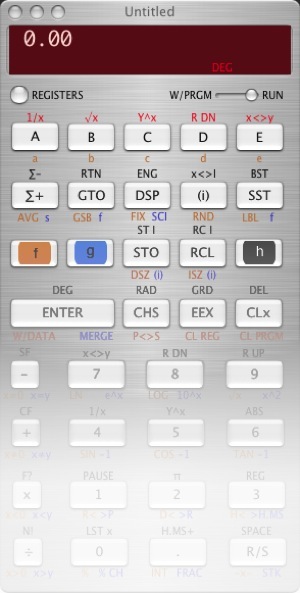This page describes the main impetus and features of LXVII. The menu on the left provides the download links to the application and documentation. It also provides links to background information on Hewlett-Packard calculators and on how to use them.
About LXVII
LXVII is an HP-67 calculator simulator for the Macintosh OS X platform. It was conceived because I needed a calculator for my taxes and after downloading a bunch of RPN based calculators I found most of them wanting. Some were lacking basic features, others had so many features they were too confusing or cumbersome to use. I plugged in my hp-67, with its long-dead batteries and magnetic card reader, and copied the answers from display to tax-forms by hand.
At about the same time, I had been looking for an application to use as a springboard for learning Mac OS X application programming. It seems that an RPN calculator is a good application for learning an object-oriented application framework, (a lot of the calculators I downloaded were starter applications.) A couple of years off-and-on, lots of reading and debugging, and a thankfully uneventful beta-release later, LXVII is ready for release.
Features
LXVII is a faithful simulation, but not exact emulator, of the hp-67. It has the same number memory registers and program steps as the original. The stack depth is the same (4 cells), the button and prefix key layout is also the same, (which unfortunately makes its on-screen footprint a bit larger than I wanted,) it displays the same key-codes per program step, it even has a slider switch for selecting between user and program mode. The impetus for keeping that level of compatibility was to give the owner of an hp-67 the ability to immediately use LXVII without worrying about what may be different.
New features were designed with the intent that they extend existing features in a matter that is compatible with existing behavior.
Among the new features are:
-
• Unlike most other calculator programs, LXVII is document based. This means you can have multiple calculators, running multiple programs, active at the same time. LXVII takes advantage of Cocoa threads, so it also takes advantage of as many CPUs as are available on the system.
-
•The document based architecture allows users to redefine LXVII’s functionality so that each document is essentially a new calculator, tailored to the user’s specific task.
-
•A paper tape mode like that found on the hp-97 desktop calculator is provided for printing out memory registers, intermediate stack values and program listings.
-
•A pull-out drawer panel can display the current values of the stack, the last-X register, the program counter, all memory locations and all program steps in memory. All values except the program steps can be edited directly within the drawer interface.
-
•All buttons have an assigned single-keystroke key so the user can get to all calculator functions without use of the mouse. To help remember the keystrokes, all buttons and button labels have active tooltips specifying the button’s functions.
-
•The 5 programmable buttons on the first row (A-E) can be assigned labels and tooltip messages that are saved with the document.
Many other features are described in the Readme file or User Manual that accompany the program; both can be downloaded separately from the download page.
Requirements
LXVII is distributed as 2 binaries: A PowerPC only version and a Universal Binary version.
PowerPC Requirements:
-
•Any Macintosh with a G3 and later PowerPC based processor.
-
•Mac OX X 10.3 (Panther) or later
Universal Binary Requirements:
-
•Any Macintosh that is running Mac OS X 10.4.6 (Tiger) or later
A full install requires about 4 megabytes of disk space. Installing only the binary image for your machine will require about 2 megabytes.


